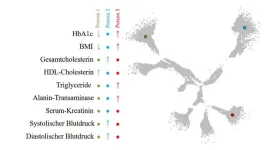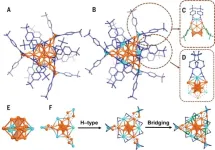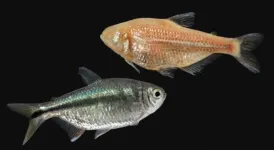(Press-News.org) Scientists trying to understand the physical and chemical properties that govern biomolecular condensates now have a crucial way to measure pH and other emergent properties of these enigmatic, albeit important cellular compartments.
Condensates are communities of proteins and nucleic acids. They lack a membrane and come together and fall apart as needed. The nucleolus is a prominent condensate in cells. It serves vital roles in cellular physiology and is the site of ribosome production.
Ribosomes are the multi-protein and RNA assemblies where the genetic code is translated to synthesize proteins. Impairment of ribosome production and other nucleolar dysfunctions lie at the heart of cancers, neurodegeneration and developmental disorders.
In a first for the condensate field, researchers from the lab of Rohit Pappu, the Gene K. Beare Distinguished Professor of biomedical engineering, and colleagues in the Center for Biomolecular Condensates in the McKelvey School of Engineering at Washington University in St. Louis, figured out how nucleolar sub-structures are assembled. This organization gives rise to unique pH profiles within nucleoli, which they measured and compared with the pH of nearby non-nucleolar condensates including nuclear speckles and Cajal bodies.
In the study, published online in Cell, the authors report that the distinct protein compositions of nucleoli give them an acidic character, whereas nuclear speckles have the same pH as the nucleus, and Cajal bodies are more basic.
Building on spatial proteomics data from the lab of Emma Lundberg, associate professor of bioengineering at Stanford University, and novel algorithms developed by Kiersten Ruff, a staff research scientist at McKelvey, and colleagues in the Pappu lab, the team identified unique “molecular grammars” including the presence of proteins with long acidic tracts as a key defining feature of many nucleolar proteins. This, the team reasoned, must help carry hydrogen protons into nucleoli (pH is the measurement of the activity of protons).
Condensates are like a gathering of people on a convention floor. There are no walls keeping them in place; just sparkling conversations led by a few key individuals — the “scaffolds.” The community of molecules that come together enables emergent properties in the condensates, like internal pH in nucleoli.
Condensates form via a process that the team now refers to as condensation. This combines phase separation — think demixing of oil and water — and sticky interactions among molecules that like to bind with one another.
“Biomolecules are defined by a combination of specific interactions and distinct solubility profiles. Condensation involves the totality of these interactions, and this gives rise to what are known as emergent properties,” said Matthew King, postdoctoral fellow in the Pappu lab and lead author of the paper.
The new research provides a starting point for understanding how emergent properties, whereby the whole is greater than the sum of its parts, give rise to condensate-specific “physicochemical barcodes,” according to King.
Differentials in pH between condensates and the surrounding nucleoplasm generate gradients and “a pH gradient generates what is known as a proton motive force,” King said.
This proton motive force, measured to be -88 mJ per proton, “might be able to facilitate directional movement of RNA and protein molecules, which is a key first step in enabling ribosomal assembly,” King added.
Getting chemical probes to the right place in cells and to measure the condensates required technological innovations that included contributions from McKelvey project partners Michael Vahey assistant professor of biomedical engineering, and Matthew Lew, associate professor of electrical and systems engineering.
According to Pappu, this work “provides an elegant solution to the challenge that many biochemists see for the condensate concept.”
Cellular reactions require specificity. Every biochemical reaction must take place in the right place, at the right time, and must involve specific sets of proteins and nucleic acids.
“Condensates were often criticized as being non-specific blobs,” Pappu said.
Thanks to this new research, those blobs clearly have specific physiochemical properties.
“We now have evidence that distinct compositional biases of condensates generate distinct physicochemical environments, and this might provide the basis for biochemical specificity,” Pappu noted.
END
WashU engineers manage a first: measuring pH in cell condensates
2024-03-18
ELSE PRESS RELEASES FROM THIS DATE:
Study with innovative insights into the heterogeneity of type 2 diabetes
2024-03-18
A landmark study by the German Diabetes Center (DDZ), published in The Lancet Diabetes & Endocrinology, sheds new light on the heterogeneity of type 2 diabetes. The researchers employed an innovative algorithm to stratify people with type 2 diabetes using routine data and thus visualize the metabolic diversity of diabetes.
Type 2 diabetes is a disease with highly diverse progression pathways. Using an innovative algorithm, a team led by the German Diabetes Center (DDZ) used routinely measured variables to open up new perspectives on the diversity of type 2 diabetes in terms of insulin sensitivity, insulin secretion, ...
Breakthrough in melting point prediction: over 100-year-old physics problem solved by Queen Mary Professor
2024-03-18
A longstanding problem in physics has finally been cracked by Professor Kostya Trachenko of Queen Mary University of London's School of Physical and Chemical Sciences. His research, published in the Physical Review E, unveils a general theory for predicting melting points, a fundamental property whose understanding has baffled scientists for over a century.
For decades, our understanding of the three basic states of matter – solids, liquids, and gases – relied on temperature-pressure phase diagrams. These diagrams depict the conditions under which each state exists, with distinct lines separating them. However, one crucial line, ...
Shining a light on the underpinnings of rare disease impacting children
2024-03-18
A team from the University of Ottawa's Faculty of Medicine has completed an exciting new study that reveals the inner workings of gene mutations that result in an ultra-rare syndrome with fewer than 100 reported cases since its first description in the early 1960s.
The hard-won research discovery may accelerate the development of a treatment for Borjeson-Forssman-Lehmann Syndrome (BFLS), a neurodevelopmental disorder linked to the X chromosome that’s characterized by seizures, intellectual disability, and behavioural ...
Landmark study shows that ‘transcendent’ thinking may grow teens’ brains over time
2024-03-18
Scientists at the USC Rossier School of Education’s Center for Affective Neuroscience, Development, Learning and Education (CANDLE), have shown for the first time that a type of thinking, that has been described for over a century as a developmental milestone of adolescence, may grow teenagers’ brains over time. This kind of thinking, which the study’s authors call “transcendent,” moves beyond reacting to the concrete specifics of social situations to also consider ...
Reimagining the future of solar energy
2024-03-18
Scientists are always on the lookout for ways to make our world a better place, and one area they're focusing on is solar energy. One idea in this area is to make solar cells more efficient by concentrating more solar light onto them. While investigating this recently, a group of scientists at the Cavendish Laboratory and AMOLF (Amsterdam NL) have found that improving solar cells efficiency in this way is harder than we might think but have discovered other avenues by which it might be possible to improve solar energy capture anywhere on the planet.
The researchers ...
Metformin during pregnancy impacts offspring brain development
2024-03-18
With the rise in gestational diabetes and metabolic disorders during pregnancy, metformin is also being prescribed more frequently. Although it is known that the oral antidiabetic agent can cross the placental barrier, the impacts on the brain development of the child are largely unknown. An interdisciplinary research team from the German Institute of Human Nutrition Potsdam-Rehbrücke (DIfE) have now been able to demonstrate in a mouse model that although metformin has positive effects in pregnant animals, it does not in the offspring. The results were published in the specialist ...
Johns Hopkins Medicine-led team develops fluid biomarker for early detection of ALS and FTD
2024-03-18
Two progressively degenerative diseases, amyotrophic lateral sclerosis (ALS, commonly known as Lou Gehrig’s disease) and frontotemporal dementia (FTD, recently in the news with the diagnoses of actor Bruce Willis and talk show host Wendy Williams), are linked by more than the fact that they both damage nerve cells critical to normal functioning — the former affecting nerves in the brain and spinal cord leading to loss of movement, the latter eroding the brain regions controlling personality, behavior and language.
Research studies have repeatedly shown that in patients with ALS or FTD, the function of TAR DNA-binding protein 43, more commonly called TDP-43, ...
A new antibody capture method reveals G-quadruplex landscape and its regulation
2024-03-18
“[...] we present an improved method for G4 landscape determination and by applying it we show that sequence property-specific constraints of the nuclear environment mitigate G4 formation.”
BUFFALO, NY- March 18, 2024 – A new research paper was published in Oncotarget's Volume 15 on March 14, 2024, entitled, “G-quadruplex landscape and its regulation revealed by a new antibody capture method.”
In this new study, researchers Subhamoy Datta, Manthan Patel, Chakkarai Sathyaseelan, Chandrama Ghosh, Akanksha Mudgal, Divyesh Patel, Thenmalarchelvi Rathinavelan, ...
Researchers achieve >99% photoluminescence quantum yield in metal nanoclusters
2024-03-18
Prof. ZHOU Meng’s research team from the University of Science and Technology of China (USTC) of the Chinese Academy of Sciences (CAS), collaborating with Prof. WANG Quanming’s team from Tsinghua University (THU) achieved near-unity room-temperature photoluminescence quantum yield (PLQY) (>99%) in the near-infrared (NIR) emission of metal nanoclusters in solution. Their work was published in Science.
Gold nanoclusters (Au NCs) as NIR-emissive materials hold potential in biomedical applications. However, the PLQY of Au NCs in NIR region is typically low, often ...
Overeating and starving both damage the liver: Cavefish provide new insight into fatty liver disease
2024-03-18
KANSAS CITY, MO—March 18, 2024—Fatty liver, which can lead to liver damage and disease, can occur from both overeating and starvation. Now, new research shows how naturally starvation-resistant cavefish, unlike other animals, are able to protect their liver and remain healthy. The findings have implications for understanding and potentially addressing liver conditions in humans.
Researchers from the Stowers Institute for Medical Research in collaboration with Université Libre de Bruxelles in Belgium and Iowa State University ...






